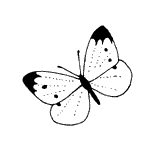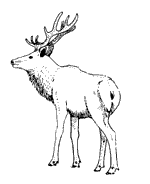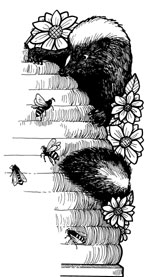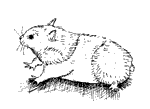|
All of the books listed below look at ways
animals defend themselves by using specific behaviors, structures,
and surroundings. Animals featured in the books range from small
fish to dinosaurs. Stories include the relationships between a
clownfish and an anemone with protective tentacles, a mouse and
a discarded pumpkin shelter, and a day in the life of a camouflaged
lizard. In a direct connection with the students’ animals
“meeting” a Tyrannosaurus rex in the GEMS activities,
two books address youthful enthusiasm for dinosaurs by describing
what these prehistoric creatures were like and how they used their
distinctive features, such as spines, horns, and teeth.
Curious Clownfish
Dinosaurs are Different
Dinosaurs, Dinosaurs
Eric Carle’s Animals Animals
A House for Hermit Crab
Lizard in the Sun
The Mixed-Up Chameleon
Mousekin’s Golden House
Pretend You’re A Cat
Swimmy
Curious Clownfish
by Eric Maddern; illustrated by Adrienne Kennaway
Little, Brown & Co., Boston. 1990
Grades: K–3
A baby clownfish wants to leave the protection of the anemone
whose stinging tentacles he keeps clean. During his adventure
exploring a coral reef he encounters a sea slug, porcupine fish,
dragon fish, crab, cuttlefish, and a terrifying eel. They all
demonstrate their defense mechanisms and he is grateful to return
to the anemone. The bold neon illustrations depict a beautiful
undersea world as well as clearly showing defensive behaviors.
Return to title list.
Dinosaurs are Different
by Aliki
Harper & Row, New York. 1985
Grades: K–3
Explains how the various orders and suborders of dinosaurs
were similar and different in structure and appearance. A good
catalogue of dinosaur defenses.
Return to title list.
Dinosaurs, Dinosaurs
by Byron Barton
Thomas Y. Crowell, New York. 1989
Grades: K–2
In prehistoric days there were many different kinds of dinosaurs,
big and small, those with spikes and those with long sharp teeth.
Perfect to read either before or after Session 1 of the GEMS guide.
Return to title list.
Eric Carle’s Animals Animals
compiled by Laura Whipple; illustrated by Eric Carle
Philomel/Putnam & Grosset, New York. 1989
Grades: K–5
Anthology of over 50 poems from many cultures on both wild
and domestic animals illustrated with Carle’s joyous color
collages. The poems cover a wide range of topics, and some, such
as those on the barracuda, porcupine, and narwhal, focus particularly
on animal defenses.
Return to title list.
A House for Hermit Crab
written and illustrated by Eric Carle
Picture Book Studio, Saxonville, Massachusetts. 1987
Grades: Preschool–2
One day Hermit Crab moves out of the house he has outgrown
and finds a bigger shell “house” that is perfect but
plain. He collects sea anemones, starfish, coral, snails, sea
urchins, lantern fish, and pebbles to adorn it. When he outgrows
that home, he finds a bigger one with new possibilities for decorating—barnacles,
clown fish, sand dollars, electric eels, and so on. An additional
page of text in front and back gives more information about the
crab’s habit and defenses used by other creatures such as
poisonous spines or camouflage.
Return to title list.
Lizard in the Sun
by Joanne Ryder; illustrated by Michael Rothman
William Morrow, New York. 1990
Grades: Preschool–2
The friendly narration guides you through your day as a lizard;
you are camouflaged from hungry birds and hidden from insects
that become your next meal. Children enjoy seeing the natural
world from a lizard’s viewpoint, and learn firsthand facts
about a lizard’s lifestyle.
Return to title list.
The Mixed-Up Chameleon
by Eric Carle
Harper & Row, New York. 1975
Grades: Preschool–2
A bored chameleon wishes it could be more like all the other
animals it sees, but soon decides it would rather just be itself.
Protective coloration (the chameleon changes color according to
the surface on which it rests) and energy (when the chameleon
is warm and full, it turns one color, when cold and hungry, it
turns another) are woven into the story, as are a discussion of
attributes of various other animals.
Return to title list.
Mousekin’s Golden House
written and illustrated by Edna Miller
Prentice-Hall, Englewood Cliffs, New Jersey. 1964
Simon & Schuster, New York. 1987
Grades: K–3
Mousekin acquires an unusual tool for self defense in the
forest—a discarded jack-o-lantern in which he hides from
a hungry young owl, a cat, and a box turtle. As the cut-out spaces
in the pumpkin slowly melt together, he has an even cozier golden
house.
Return to title list.
Pretend You’re A Cat
by Jean Marzollo; illustrations by Jerry Pinkney
Dial Books, New York. 1990
Grades: Preschool–1
Wonderful illustrations and friendly verse ask children, “Can
you chatter and flee? Disappear in a tree? ... What else can you
do like a squirrel?” Young readers love to read the verse
and then act out the animal’s behavior. Animals include a
cat, pig, snake, bear, horse, and seal. Great springboard to a
discussion of similarities and differences among animal behaviors.
Return to title list.
Swimmy
by Leo Lionni
Alfred A. Knopf, New York. 1987
Grades: K–4
A clever little black fish discovers a way for her school
of little red fish to swim together and be protected from larger
predators. With Swimmy as the “eye,” the fish swim in
formation masquerading as a big fish.
Return to title list.
|




|

